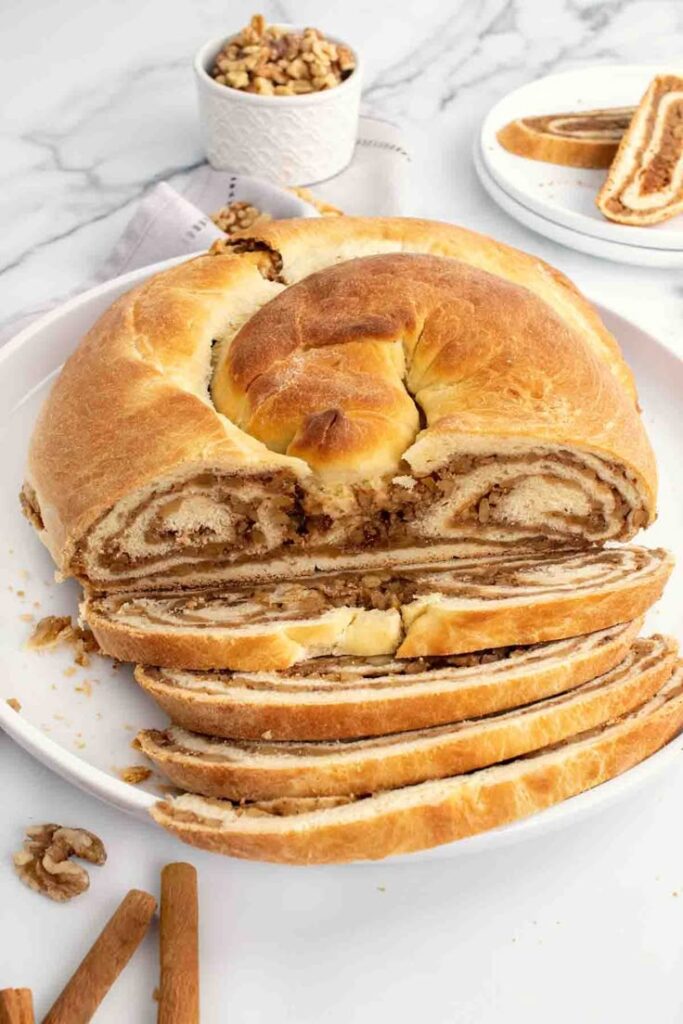
Authentic Potica (Traditional Slovenian Nut Roll) – A Hungarian Twist
Potica, a traditional Slovenian dessert, is a delectable, rich, and spiced nut-filled pastry that has captivated hearts across Central and Eastern Europe for generations. Its soft, sweet yeast dough envelops a thick, flavorful filling made of ground walnuts, sugar, spices, and sometimes even a splash of rum or honey. While Potica originates from Slovenia, its popularity extends to neighboring countries, including Hungary, where the recipe is adapted with local touches.
In Hungary, Potica can take on several variations, including a twist with dark chocolate, Hungarian paprika, or even incorporating Hungarian honey to give it a unique local flair. In this article, we’ll dive into the process of making this authentic nut roll, highlighting the Hungarian influence and showcasing how easy it is to make this timeless dessert at home.
Origins of Potica: A Slovenian Classic
Potica has been baked in Slovenia for centuries, often associated with family gatherings, celebrations, and special occasions like Christmas or Easter. The earliest mentions of Potica can be found in Slovenian historical records, which date back to the 16th century. Traditionally, Potica was prepared for holidays, as the rich dough and filling were reserved for special occasions.
The recipe itself is quite versatile—while walnuts are the most common filling, people have historically filled their Potica with everything from hazelnuts to poppy seeds. However, it is the walnut filling that remains the most iconic version of the treat.
As the recipe spread beyond Slovenia’s borders, it began to undergo small adaptations depending on regional preferences and available ingredients. In Hungary, the addition of spices, nuts, and even the use of chocolate or paprika helped create a variation of the classic that reflects local taste profiles.
What Makes Potica Special?
What sets Potica apart from other rolls and pastries is its intricate layering technique. The dough is stretched thin, and the filling is spread evenly over it. The dough is then rolled up like a jelly roll, creating layers of dough and filling that form a spiral as the loaf bakes. This unique structure is one of the defining features of Potica, making it not just delicious, but visually stunning.
Additionally, the dough itself is a yeast-based dough, which makes it wonderfully soft and tender. It provides the perfect contrast to the rich, nutty filling.
Ingredients: The Building Blocks of Potica
Before we begin, let’s look at the essential ingredients for making Authentic Potica, with a Hungarian twist. Many of these ingredients are easy to find in your local grocery store, and some, like honey, might even be available from a local Hungarian shop.
For the Dough:
- 4 cups all-purpose flour
- 1 packet active dry yeast (or 2 1/4 teaspoons)
- 1/2 cup whole milk
- 1/4 cup granulated sugar
- 2 large eggs
- 1/4 cup unsalted butter, melted
- 1/2 teaspoon salt
- 1 teaspoon vanilla extract
- Zest of 1 lemon
- 1 tablespoon rum (optional, adds depth of flavor)
For the Nut Filling:
- 2 cups walnuts, finely chopped or ground
- 1/2 cup granulated sugar
- 1 teaspoon cinnamon
- 1/4 teaspoon ground cloves
- 1/4 teaspoon ground nutmeg
- 1/2 cup whole milk (or just enough to make the mixture moist but not runny)
- 1 tablespoon honey
- 1 tablespoon dark rum (optional for extra flavor)
- 1/2 cup dark chocolate chips (for the Hungarian twist!)
For the Glaze:
- 1 tablespoon unsalted butter, melted
- 2 tablespoons powdered sugar
Step-by-Step Instructions to Make Authentic Potica
Step 1: Preparing the Dough
- Activate the Yeast: Begin by activating your yeast in lukewarm milk. In a small bowl, combine the milk and sugar, and sprinkle the yeast over it. Let it sit for about 5-10 minutes until it becomes foamy. This is an essential step to ensure your dough rises properly.
- Combine Dry Ingredients: In a large mixing bowl, sift the flour and salt together. Create a well in the center to add the wet ingredients.
- Add Wet Ingredients: Once your yeast is activated, pour the yeast mixture into the flour, and add eggs, melted butter, vanilla extract, and lemon zest. Mix the dough together until it begins to form a rough dough ball.
- Knead the Dough: Transfer the dough to a clean surface and knead it for about 8-10 minutes. If the dough is too sticky, add a little extra flour, but be careful not to make it too dry. The dough should be soft and smooth when finished.
- Let it Rise: Place the dough in a greased bowl, cover it with a clean cloth, and let it rise in a warm, draft-free area for about 1 to 1.5 hours. The dough should double in size.
Step 2: Preparing the Nut Filling
- Prepare the Walnuts: Finely chop or grind the walnuts. You can use a food processor or a nut grinder for this. The finer the walnuts, the smoother your filling will be.
- Mix the Filling: In a large bowl, combine the ground walnuts, sugar, cinnamon, cloves, and nutmeg. Stir well until evenly mixed.
- Add Liquids: Gradually add the milk to the walnut mixture until it reaches a spreadable consistency (not too thick and not too runny). Stir in the honey and dark rum for an extra depth of flavor.
- Optional Twist: For a Hungarian touch, add dark chocolate chips to the mixture for a rich, decadent flavor that pairs wonderfully with the walnuts.